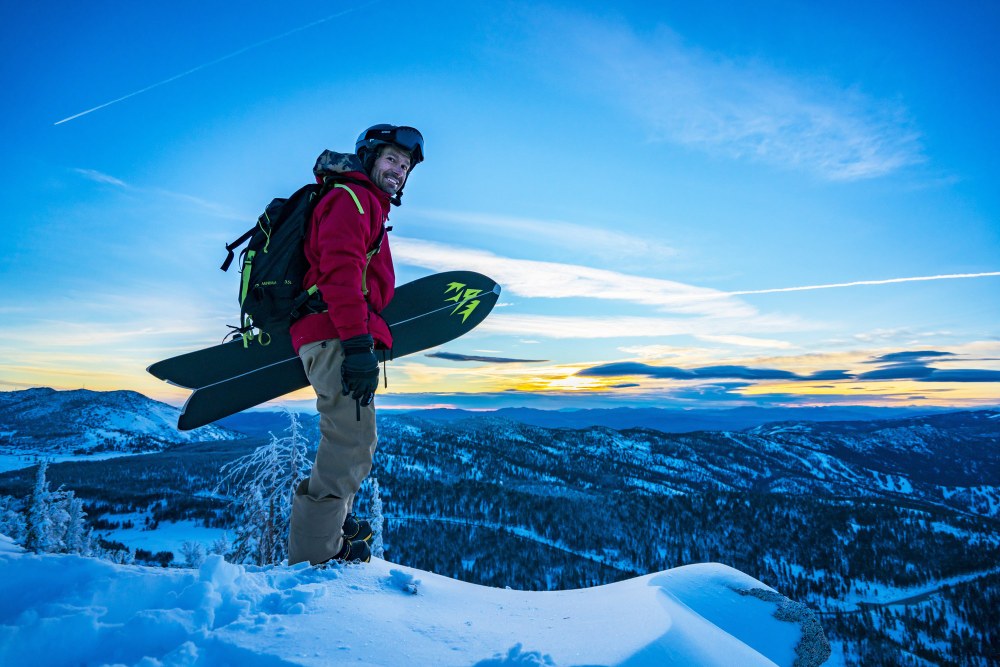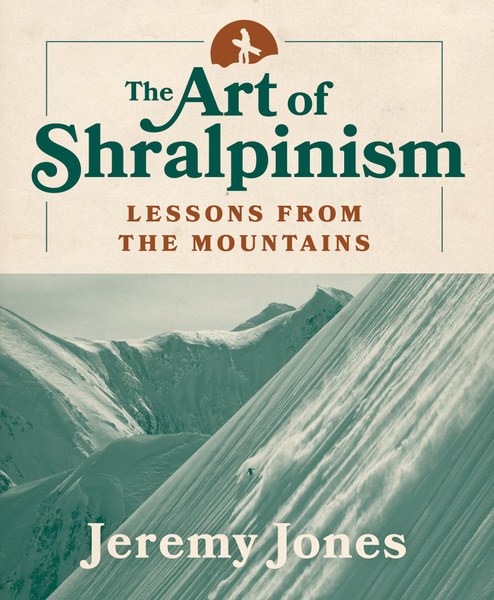
Widely regarded as one of the world’s most legendary alpinists, National Geographic Adventurer of the Year Jeremy Jones is an award-winning snowboarder, environmentalist, and entrepreneur. The founder of climate nonprofit Protect Our Winters (POW) and owner of Jones Snowboards, Jones has starred in dozens of snowboard films, including his highly acclaimed trilogy Deeper, Further, and Higher, and received 11 “Big Mountain Rider of the Year” awards from Snowboarder Magazine. His first book The Art of Shralpinism: Lessons from the Mountains (Mountaineers Books, 2022) explores the life-changing power of time in the mountains, the value of stoke, and how beauty and openness underscore all outdoor adventure. Please enjoy the following excerpt.
Two years into backcountry filming, Ryland and I are poised to drop into the biggest spine wall of our lives. We had climbed and bivied at the top of the face, waiting for morning to come. Picking up speed, I find my flow. Even though I’m in total control, there is no way I can stop. The slope is too steep and each turn creates small sluffs that build into small avalanches. These are predictable slides, and depending on my appetite, I mix it up and play with them like a surfer plays with a wave. We call this “sluff management.” But my internal Spidey sense knows that I have monster sluff building above me and to my left. Moving at the same speed as the sluff, I feel the weight starting to grab the tail of my snowboard. An essential rule in sluff management is to never sluff your exit - or at least get to your exit before your sluff does or find a safe spot to pull up on an “island of safety” while the sluff cascades through your line. This is poor sluff management, something I try to avoid at all costs.
My exit is to my right, off the smallest part of the cliff. I purposefully do not ride above it until the end of my line in order to leave it clean. This means that the majority of my line is over the biggest part of the cliff. Cut over too early and I sluff my exit, too late and I’m dragged off a huge cliff and get seriously hurt or worse. As much as I wrestled with this in the days leading up to my line, my mind is totally free of any such thought. I bounce down the spines and dabble with a rare “white moment.” Everything is quiet, despite the rush of my sluff and the wind. Hundreds of micro-decisions and adjustments are being made, but I give them no thought. My mind and body are one. I perfectly position myself over my exit air just as my sluff reaches it. Together we fly through the air like I am jumping a snow waterfall. The landing is soft and steep, and although it is now partially hidden from the explosion of my sluff off the cliff, I stomp the landing. Coming out of the smoke, I wait a few seconds and then lean into a few celebratory powder turns before straight running toward the glacier valley below. My body shakes. Uncontrollable screams are followed by sobs and tears.
Ryland and I have just ridden one of the best lines of our lives, all under our own power. A huge achievement for the time. That line will stay with me forever, but all I can really think about is that I will see my infant daughter and wife again. That I will live to ride another day. The sad truth is that too many of my friends, heroes, and mentors have not lived to ride another day.
What follows in the pages of this book are the people and experiences that define me. I’m not proud of every decision I’ve made in the mountains, but often we learn the most from our mistakes. The trick is not dying in the process. I’m not better than those who’ve fallen to the mountains. I’ve tried to be honest about the risks, stack the deck as much as possible, pick the right time to walk on the moon and with the right plan and the right people. I’ve tried to be present enough to know when the mountains lie down and welcome you, or when the danger scale tilts too far in the wrong direction and it is time to back off.
At the heart of this passion is the ability to push through significant mental and physical barriers when the struggle is grand but also to have the wherewithal and awareness to recognize nature’s subtle signs that turn a green light to red in an instant, requiring you to abandon one of your life’s greatest goals. This mix of gusto and humility, fearlessness and fear, grit and sensitivity, requires a deep understanding of who you are as a person at your innermost core, as well as an intimate connection with nature and your partners, plus a deep understanding of the behaviors, characteristics, and subtleties of all things snow. This is the Art of Shralpinism.
The Art of Shralpinism: Lessons from the Mountains is available for purchase at our Seattle Program Center Bookstore, online at mountaineersbooks.org, and everywhere books are sold.
This article originally appeared in our winter 2023 issue of Mountaineer magazine. To view the original article in magazine form and read more stories from our publication, visit our magazine archive.
 Jeremy Jones
Jeremy Jones

